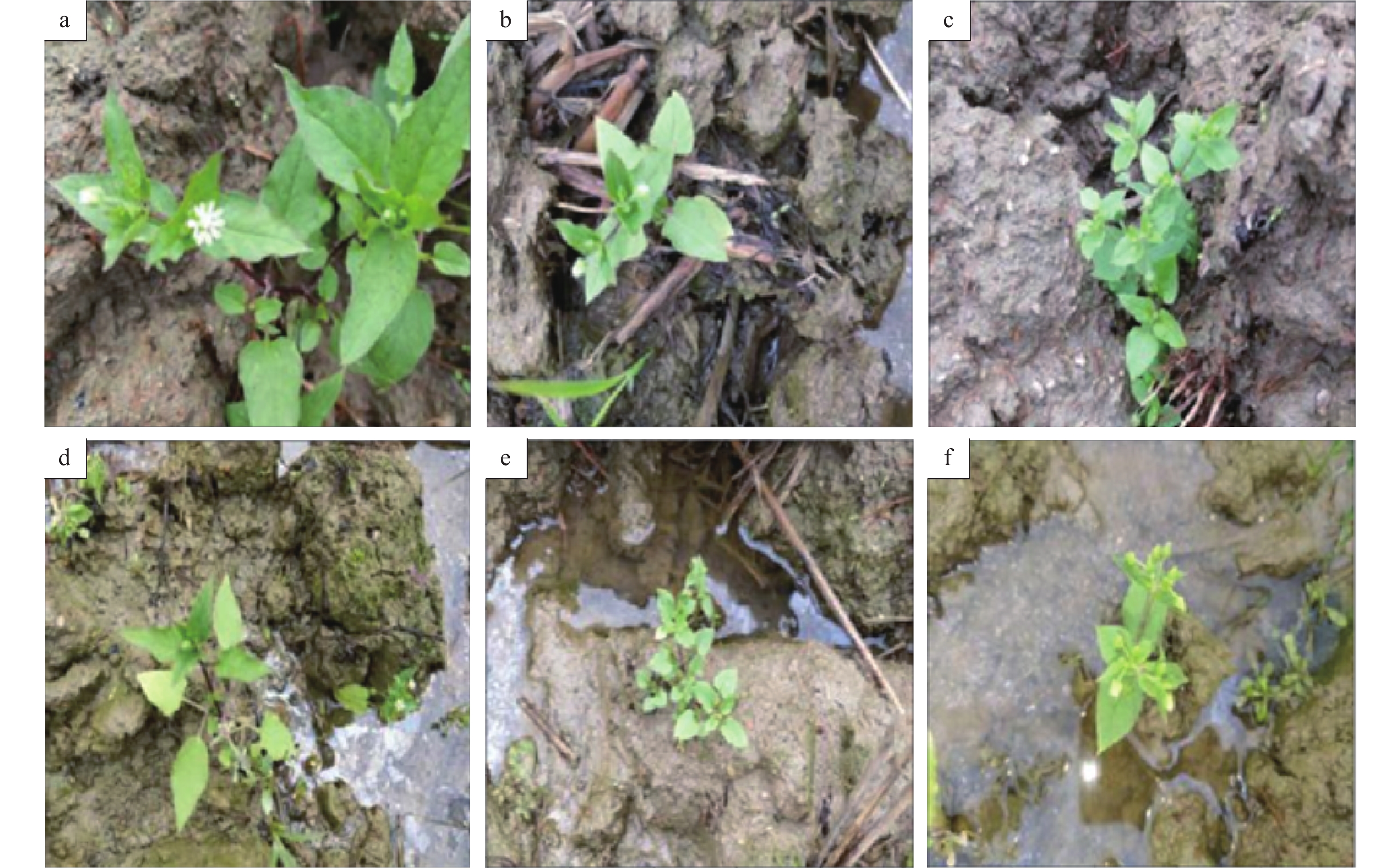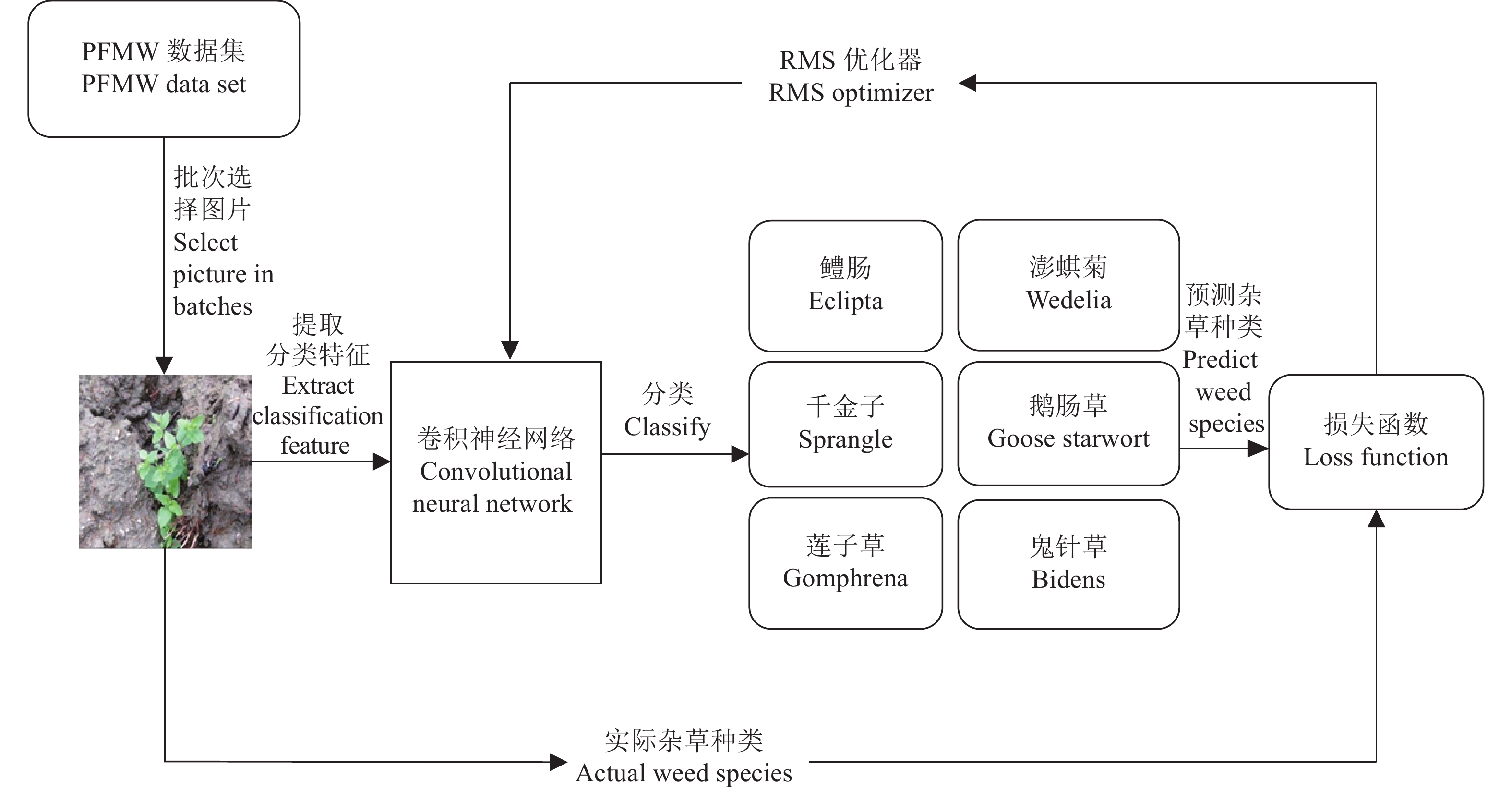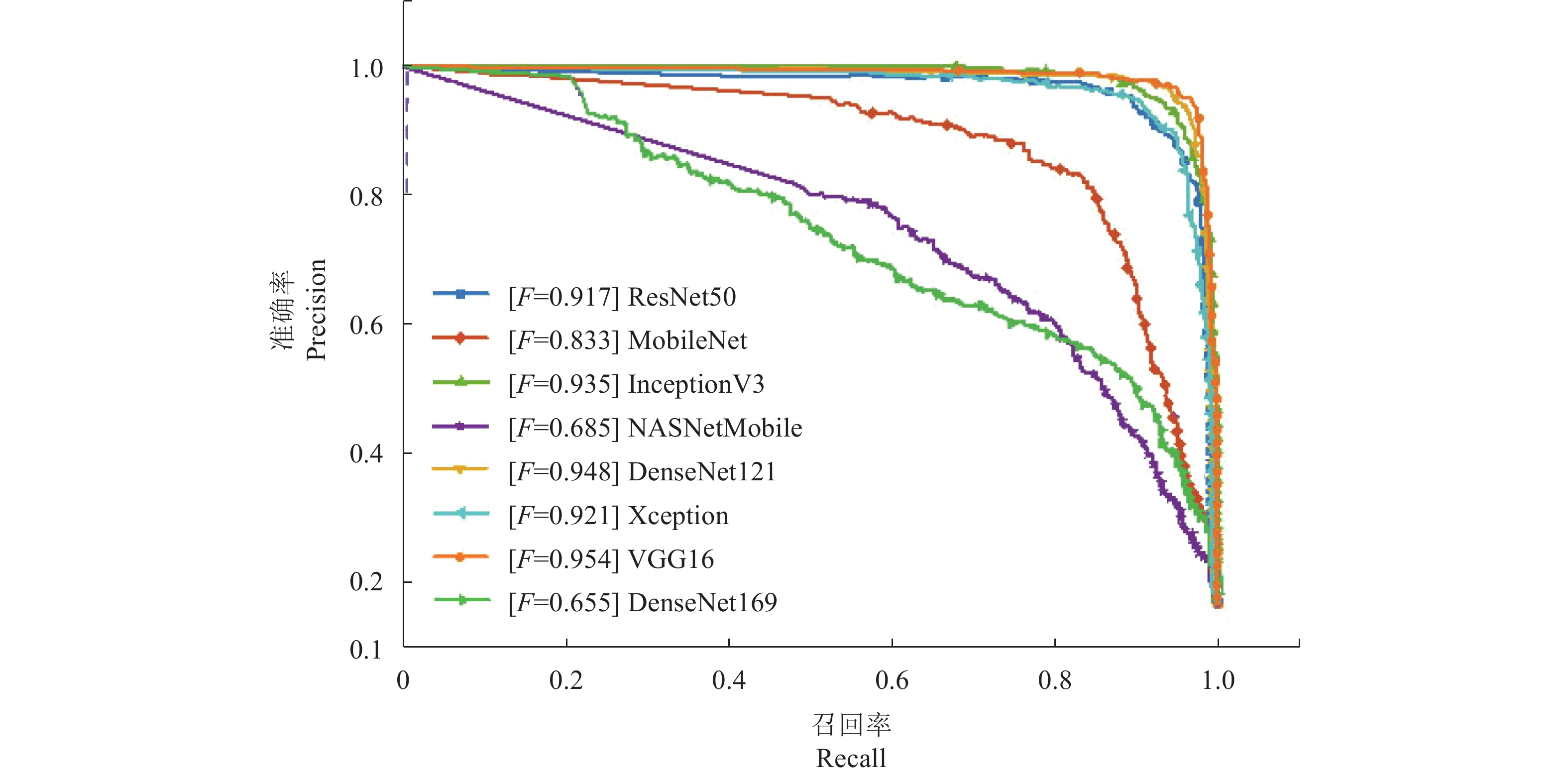Research on paddy weed recognition based on deep convolutional neural network
-
摘要:目的
利用深度卷积神经网络对水稻田杂草进行准确、高效、无损识别,得出最优的网络模型,为水稻田种植管理以及无人机变量喷施提供理论依据。
方法以水稻田杂草为主要研究对象,利用CCD感光相机采集杂草图像样本,构建水稻田杂草数据集(PFMW)。利用多种结构的深度卷积神经网络对PFMW数据集进行特征的自动提取,并进行建模与试验。
结果在各深度模型对比试验中,VGG16模型取得了最高精度,其在鬼针草、鹅肠草、莲子草、千金子、鳢肠和澎蜞菊6种杂草中的F值分别为0.957、0.931、0.955、0.955、0.923和0.992,其平均F值为0.954。在所设置的深度模型优化器试验中,VGG16-SGD模型取得了最高精度,其在上述6种杂草中的F值分别为0.987、0.974、0.965、0.967、0.989和0.982,其平均F值为0.977。在PFMW数据集的样本类别数量均衡试验中,无失衡杂草数据集训练出来的VGG16深度模型的准确率为0.900,而16.7%、33.3%和66.6%类别失衡的数据集训练的模型准确率分别为0.888、0.866和0.845。
结论利用机器视觉能够准确识别水稻田杂草,这对于促进水稻田精细化耕作以及无人机变量喷施等方面具有重要意义,可以有效地协助农业种植过程中的杂草防治工作。
Abstract:ObjectiveTo accurately, efficiently and non-destructively identify the weeds in rice field using deep convolutional neural network, obtain the optimal network model, and provide a theoretical basis for rice field planting management and variable drone spraying.
MethodThe weeds in rice field were taken as the main research object, and weed image samples were collected by CCD photosensitive camera to construct weed data set (PFMW) in rice field. The deep convolutional neural network with multiple structures was used to automatically extract the features of the PFMW data set, and then to model and test.
ResultVGG16 model achieved the highest precision among all the deep learning models, the F values in Bidens, Goose Starwort, Gomphrena, Sprangle, Eclipta, Wedelia were 0.957, 0.931, 0.955, 0.955, 0.923 and 0.992 respectively, and the average F value was 0.954. The VGG16-SGD model achieved the highest precision in setted deep model optimizer experiments, the F values in each weed mentioned above were 0.987, 0.974, 0.965, 0.967, 0.989 and 0.982 respectively, and the average F value was 0.977. In the equilibrium experiments of sample category quantity in the dataset, the accuracy of the VGG16 model trained by the balanced weed dataset was 0.900, while those of the models trained by the 16.7%, 33.3% and 66.6% category imbalance dataset were 0.888, 0.866 and 0.845 respectively.
ConclusionThe machine vision and other advanced technologies can accurately identify weeds in rice field. It is of great significance for promoting fine cultivation of rice field and variable drone spraying, etc., and the technology can effectively assist weed control in the process of agricultural planting.
-
Keywords:
- computer vision /
- paddy weed /
- deep convolutional neural network /
- model optimizer
-
水稻是我国主要粮食作物,在粮食生产中占有极其重要的地位。我国是水稻生产大国,水稻种植面积居世界第2位,总产量居第1位,单产高于世界稻谷平均单产近1倍,位居世界前列[1]。而杂草对水稻种植的影响很大,主要包含以下方面:1)杂草与水稻共处同一生长环境,会与水稻抢夺必须的肥料、水分、土壤资源以及生长所需的空间;2)杂草同时也为农作物害虫或其他有害寄生菌提供了良好的栖息环境[2]。因此,杂草的防治始终是水稻种植中最基本的任务。由于水稻田杂草防治会耗费大量的人力物力,因此利用机器视觉发展的先进成果,精准有效地对水稻田杂草进行识别与防治是我国农业经济发展提升的一个关键环节。
Lecun等[3]提出的卷积神经网络(Convolution nerual network, CNN)是机器学习的经典模型,。随着深度学习理论以及硬件条件的不断发展,人类能够构建更深层的神经网络。注意力机制(Attention-based model)在深度网络中的应用是近年来机器视觉领域发展的里程碑,选择性搜索(Seletive search)是注意力机制在目标识别网络上的体现,其最初应用在R-CNN(Region proposal CNN)网络中,用以初筛选冗余的目标区域并提高物体识别网络的性能[4]。但是选择性搜索会在ROI区域附近生成多个冗余的候选目标区域,CNN网络针对每个候选目标区域都需要计算物体识别的结果,严重影响了目标识别网络的性能。为了进一步提高模型性能,Lin等[5]提出了Fast R-CNN网络,利用目标区域提议网络(Region proposal network, RPN)生成候选目标区域。基于卷积神经网络深度模型的缺陷在于对于已训练的模型,其只能处理宽度和高度尺寸相同的输入图像,通常的解决办法是在输入图像之前作剪裁等归一化操作,但是这样的归一化操作往往会影响图像的语义信息或者目标物体的形状,从而导致图像识别模型精度降低。Ren等[6]提出了SPP网络(Spatial pyramid pooling network),SPP网络通过在卷积层和全连接层之间加入1个空间池化操作使得CNN可以处理不定尺寸的输入图片,拓宽了卷积神经网络能力范围,并且提高了深度模型的精度。
图像识别技术在杂草识别的应用上早已有所实践[7-10],El-Faki等[11-12]利用杂草叶片与成熟作物的颜色差异简单区分杂草与作物。而如今最为主流的是基于深度学习模型的图像识别技术[13-14],杨会清等[15]利用BP神经网络设计了一种田间除草综合评价模型,可以快速精确地输出田间除草等级。孙俊等[16]利用空洞卷积结合全局池化的卷积神经网络对幼苗与杂草进行了识别,模型能达到较高的平均识别准确率及分类成功率。但总体来说利用深度学习模型对杂草进行识别的相关研究较少[17-18],因此,本文从田间杂草精准防治命题出发,以水稻田常见的伴生杂草为主要研究对象,进行传统机器学习方法和深度模型对照试验,以期能为农业种植中的杂草精准防治以及农业信息化、智能化、机械化生产作出一定的理论和实践探索。
1. 材料与方法
1.1 试验环境
模型的训练在TensorFlow框架下完成,硬件环境:华擎B450主板、Intel I5 8500 2.8GHzCPU、16G DDR4 2133MHz内存、GTX1060 6G显存显卡。软件环境:CUDA toolkit9.0、CUDNN V7.0;Python3.5.2;TensorFlow-GPU1.8.0;Windows10的64位操作系统;编程语言为Python。
1.2 数据来源
分别于2018年4月5日以及同年8月10日在华南农业大学水稻试验田中采集田间杂草图像数据。采集设备为Cannon EOS800D单反相机,镜头型号为EF-S18-55 mm f/4-5.6 IS STM,其有效像素为2420万像素,满足杂草图像采集的要求。相机采集图像的高度应比照正常的农业种植机械能够安装摄像头的高度,这个高度约为15~60 cm,图像采集的角度为摄像头和地面呈60°~90°的夹角。杂草图像采集需要对不同天气光照状况、不同背景复杂度以及不同杂草类型等各个方面的因素作综合考虑,以增强数据集的通用性,其中水稻田中杂草图像采集的背景复杂度主要是由水面反射的阳光、秸秆和泥土混合以及浑水等因素构成,水稻田中充足的水分为各类生物的生长提供了良好的环境。采集图像背景主要包括水面、泥水混合、干湿土壤以及秸秆等,图像采集的天气条件为阴天,当采集光照条件不足的时候采用闪光灯进行补光。PFMW数据集中不同背景下的水稻田杂草图像样本如下图1所示。根据长江中下游地区稻田优势杂草物种的研究[19-20],本文选择水稻田中优势杂草类别构建PFMW数据集[21-23]。数据集包含水稻田杂草图像共1364幅,其中鬼针草Bidens pilosa(Bidens)156幅、鹅肠草Cerastium aquaticum(Goose starwort)164幅、莲子草Gomphrena sessilis(Gomphrena)188幅、千金子Leptochloa chinensis(Sprangle)293幅、鳢肠Eclipta prostrata(Eclipta)173幅、澎蜞菊Wedelia chinensis(Wedelia)390幅。
![]() 图 1 PFMW数据集中不同背景下的杂草图像样本a:湿泥土背景;b:秸秆泥土混合背景;c:干泥土背景;d:湿泥土混水背景;e:湿泥土秸秆背景;f:闪光灯补光背景Figure 1. Samples of weed images in different backgrounds in PFMW dataseta: Wet nud background; b: Straw-mud-mixed background; c: Dry mud background; d: Wet mud-water-mixed background; e: Wet mud-straw-mixed background; f: Fill-in flash background
图 1 PFMW数据集中不同背景下的杂草图像样本a:湿泥土背景;b:秸秆泥土混合背景;c:干泥土背景;d:湿泥土混水背景;e:湿泥土秸秆背景;f:闪光灯补光背景Figure 1. Samples of weed images in different backgrounds in PFMW dataseta: Wet nud background; b: Straw-mud-mixed background; c: Dry mud background; d: Wet mud-water-mixed background; e: Wet mud-straw-mixed background; f: Fill-in flash background1.3 分析方法
在深度学习模型中,利用卷积层作为特征提取器,试验选用的模型分别为标准ResNet50、MobileNet、InceptionV3、NASNetMobile、DenseNet121、Xception、VGG16、DenseNet169。
本试验模型的优化器选择RMS,将模型学习率统一设置为0.0001,损失函数采用交叉熵损失函数,损失值
$ (J) $ 的计算公式如下:$$ J=-\sum\limits _{i=1}^{K}{y}_{i}\mathrm{l}\mathrm{n}\left({p}_{i}\right), $$ 其中:
$ K $ 是杂草种类数量;$ y $ 是标签,如果类别是$ i $ ,则$ {y}_{i} $ =1,否则为0;p是神经网络的输出,也就是指类别是i的概率。深度卷积神经网络训练过程如图2所示。2. 结果与分析
2.1 基于深度学习模型的杂草识别结果
PFMW数据集上深度学习模型的准确率−召回率曲线(Precision-recall curve,PR)如图3所示。
从图3中可以看出,深度学习模型中NASNetMobile和DenseNet169模型的F值较低,DenseNet169模型的F值为深度模型中最低水平,其F值为0.655。MobileNet模型的F值为0.833,ResNet50、Xception、InceptionV3、DenseNet121和VGG16模型的精度比较接近,其F值分别为0.917、0.921、0.935、0.948和0.954,其中VGG16模型的精度最高。DenseNet121和DenseNet169模型的参数量分别为8.062 M和14.307 M,模型深度分别为121和169层,从图3中可知DenseNet121和DenseNet169模型的F值分别为0.948和0.655,试验结果表明,对于PFMW数据集,深度学习模型的层数过多会造成模型的F值严重下降。深度学习模型在不同类别杂草的F值如表1所示。
表 1 基于深度学习模型对杂草分类的F值Table 1. The F value of weed classification based on deep learning model模型
Model鬼针草
Bidens鹅肠草
Goose starwort莲子草
Gomphrena千金子
Sprangle鳢肠
Eclipta澎蜞菊
Wedelia平均值
MeanResNet50 0.915 0.919 0.875 0.873 0.931 0.969 0.917 MobileNet 0.830 0.862 0.723 0.786 0.852 0.909 0.833 InceptionV3 0.975 0.883 0.978 0.893 0.920 0.969 0.935 NASNet 0.587 0.823 0.676 0.702 0.360 0.828 0.685 DenseNet121 0.948 0.959 0.934 0.933 0.969 0.939 0.948 Xception 0.907 0.907 0.908 0.893 0.919 0.970 0.921 VGG16 0.957 0.931 0.955 0.955 0.923 0.992 0.954 DenseNet169 0.890 0.487 0.324 0.895 0.740 0.570 0.655 结合图3和表1可以看出,DenseNet121模型在杂草鹅肠草和鳢肠中取得最高F值(0.959和0.969), 而InceptionV3模型则在鬼针草和莲子草中取得最高F值(0.975和0.978),VGG16模型在千金子和澎蜞菊中取得最高F值(0.955和0.992)。
2.2 深度学习模型优化器对试验结果的影响
从前文的叙述可知优化器控制着深度学习模型训练下降的梯度,本节基于深度学习模型对常用的SGD、Adam和RMS优化器进行试验,并优选出合适的优化器,从而进一步提高模型的识别精度。从上节的试验结果可知,VGG16模型的精度较高,故本节试验的基准模型设置为经典的VGG16。
本文将各优化器的学习率均设置为0.0001,不同优化器作用下VGG16杂草分类模型的F值如表2所示。
表 2 不同优化器的VGG16模型杂草分类F值Table 2. The F value of weed classification using VGG16 model with different optimizers模型-优化器
Model-optimizer鬼针草
Bidens鹅肠草
Goose starwort莲子草
Gomphrena千金子
Sprangle鳢肠
Eclipta澎蜞菊
Wedelia均值
MeanVGG16-SGD 0.987 0.974 0.965 0.967 0.989 0.982 0.977 VGG16-Adam 0.950 0.963 0.895 0.924 0.965 0.941 0.941 VGG16-RMS 0.957 0.931 0.955 0.955 0.923 0.992 0.953 从表2可以看出,VGG16-SGD、VGG16-Adam和VGG16-RMS的F值均值分别为0.977、0.941和0.953。其中VGG16-SGD在杂草鬼针草、鹅肠草、莲子草、千金子和鳢肠中取得最高F值, 分别为0.987、0.974、0.965、0.967和0.989,VGG16-RMS在杂草澎蜞菊中取得最高F值,其值为0.992。从上述分析可知,对于VGG16模型而言,SGD优化器在上述3种优化器中为最优。
2.3 非平衡数据集对试验结果的影响
模型训练过程容易受到样本类别数量不平衡的影响,不平衡的数据集可能会导致模型效果下降,本节将针对非平衡数据集对模型准确率的影响进行试验。在PFMW数据集中,每个类别选用100幅杂草图像,每个类别随机挑选20幅图像作为测试集,各类别的杂草样本比例如表3所示。
表 3 数据集各植物类别样本数量分布比Table 3. Proportions of sample quantities for different plant types of the dataset数据集
Dataset鬼针草
Bidens鹅肠草
Goose starwort莲子草
Gomphrena千金子
Sprangle鳢肠
Eclipta澎蜞菊
Wedelia1 1.000 1.000 1.000 1.000 1.000 1.000 2 1.250 0.950 0.950 0.950 0.950 0.950 3 1.450 0.910 0.910 0.910 0.910 0.910 4 0.750 1.050 1.050 1.050 1.050 1.050 5 0.650 1.070 1.070 1.070 1.070 1.070 6 1.450 1.450 0.775 0.775 0.775 0.775 7 1.250 1.250 0.875 0.875 0.875 0.875 8 1.100 1.100 1.100 0.900 0.900 0.900 9 1.500 1.500 1.500 0.500 0.500 0.500 试验中,VGG16模型训练学习率设置为
$ 1{\mathrm{e}}^{-4} $ ,学习率衰减系数设置为$ 1{\mathrm{e}}^{-6} $ ,batch size设置为32,训练迭代次数Epoch设置为100,VGG16在各配置数据集上的识别准确率如表4所示。表 4 数据集各植物类别VGG16模型识别准确率Table 4. Recognition accuracies of VGG16 model for different plant types of the dataset数据集
Dataset鬼针草
Bidens鹅肠草
Goose starwort莲子草
Gomphrena千金子
Sprangle鳢肠
Eclipta澎蜞菊
Wedelia平均值
Average1 0.952 0.857 0.917 0.819 0.917 0.939 0.900 2 0.926 0.863 0.864 0.814 0.952 0.915 0.888 3 0.915 0.850 0.857 0.772 0.913 0.888 0.866 4 0.911 0.883 0.847 0.829 0.928 0.917 0.884 5 0.875 0.810 0.864 0.766 0.863 0.896 0.845 6 0.938 0.833 0.864 0.835 0.897 0.883 0.873 7 0.928 0.883 0.853 0.847 0.930 0.938 0.896 8 0.909 0.909 0.954 0.820 0.883 0.894 0.895 9 0.911 0.847 0.831 0.833 0.939 0.898 0.877 从表4中可以看出,平衡数据集(Dataset 1)的平均识别准确率能够达到0.900,在本试验中为最高平均识别准确率,其中,对鬼针草、鹅肠草、莲子草、千金子、鳢肠和澎蜞菊的识别准确率分别为0.952、0.857、0.917、0.819、0.917和0.939,对千金子的识别准确率较低。在16.7%类别样本数量失衡试验中,类别数量欠均衡的数据集会使得训练模型的准确率向样本数量较多的类别倾斜,倾斜程度依类别样本数量的欠均衡程度而有所不同,其中欠均衡程度较大的数据集(Dataset 3和Dataset 5)的平均准确率较低,其中Dataset 5的平均准确率为0.845,是整个试验中最低的平均准确率。在33.3%和50.0%类别样本数量的失衡试验中可以看出,多类别样本数量失衡对模型平均准确率的影响比单一类别失衡的影响略小,故采集图像样本时应该注意各杂草类别样本数量应当大致均衡,这样通过数据集训练出的模型才能在各类别杂草识别任务中达到较好的识别水平。
3. 结论
本文以华南农业大学分子育种重点试验基地的水稻田杂草为主要研究对象,构建了水稻田杂草数据集PFMW,并基于深度模型对数据集进行建模分析。采用ResNet50、MobileNet、InceptionV3、NASNetMobile、DenseNet121、Xception、VGG16、DenseNet169等深度模型对PFMW数据集进行建模与分析,并对深度模型优化器SGD、Adam、RMS进行了对比试验,主要结论如下:
1) 在深度模型的对比试验研究中,VGG16模型取得了最高精度,其在鬼针草、鹅肠草、莲子草、千金子、鳢肠和澎蜞菊中的F值分别为0.957、0.931、0.955、0.955、0.923和0.992,其平均F值为0.954。在本文所设置的深度模型优化器试验中,VGG16-SGD模型取得了最高精度,其在鬼针草、鹅肠草、莲子草、千金子、鳢肠和澎蜞菊中的F值分别为0.987、0.974、0.965、0.967、0.989和0.982,其平均F值为0.977。
2) 在本文所设计的PFMW数据集的样本类别数量均衡试验中,无失衡杂草数据集训练出来的VGG16 深度模型的准确率为0.900,而16.7%、33.3%和66.6%类别失衡的数据集训练的模型准确率分别为0.888、0.866和0.845,从试验数据可知,数据集样本数量均衡因素对训练模型的影响较大。本文研究工作为农业种植中化学农药的精准喷施以及农业信息化、智能化提供了一定的理论以及实践的依据。
-
图 1 PFMW数据集中不同背景下的杂草图像样本
a:湿泥土背景;b:秸秆泥土混合背景;c:干泥土背景;d:湿泥土混水背景;e:湿泥土秸秆背景;f:闪光灯补光背景
Figure 1. Samples of weed images in different backgrounds in PFMW dataset
a: Wet nud background; b: Straw-mud-mixed background; c: Dry mud background; d: Wet mud-water-mixed background; e: Wet mud-straw-mixed background; f: Fill-in flash background
表 1 基于深度学习模型对杂草分类的F值
Table 1 The F value of weed classification based on deep learning model
模型
Model鬼针草
Bidens鹅肠草
Goose starwort莲子草
Gomphrena千金子
Sprangle鳢肠
Eclipta澎蜞菊
Wedelia平均值
MeanResNet50 0.915 0.919 0.875 0.873 0.931 0.969 0.917 MobileNet 0.830 0.862 0.723 0.786 0.852 0.909 0.833 InceptionV3 0.975 0.883 0.978 0.893 0.920 0.969 0.935 NASNet 0.587 0.823 0.676 0.702 0.360 0.828 0.685 DenseNet121 0.948 0.959 0.934 0.933 0.969 0.939 0.948 Xception 0.907 0.907 0.908 0.893 0.919 0.970 0.921 VGG16 0.957 0.931 0.955 0.955 0.923 0.992 0.954 DenseNet169 0.890 0.487 0.324 0.895 0.740 0.570 0.655 表 2 不同优化器的VGG16模型杂草分类F值
Table 2 The F value of weed classification using VGG16 model with different optimizers
模型-优化器
Model-optimizer鬼针草
Bidens鹅肠草
Goose starwort莲子草
Gomphrena千金子
Sprangle鳢肠
Eclipta澎蜞菊
Wedelia均值
MeanVGG16-SGD 0.987 0.974 0.965 0.967 0.989 0.982 0.977 VGG16-Adam 0.950 0.963 0.895 0.924 0.965 0.941 0.941 VGG16-RMS 0.957 0.931 0.955 0.955 0.923 0.992 0.953 表 3 数据集各植物类别样本数量分布比
Table 3 Proportions of sample quantities for different plant types of the dataset
数据集
Dataset鬼针草
Bidens鹅肠草
Goose starwort莲子草
Gomphrena千金子
Sprangle鳢肠
Eclipta澎蜞菊
Wedelia1 1.000 1.000 1.000 1.000 1.000 1.000 2 1.250 0.950 0.950 0.950 0.950 0.950 3 1.450 0.910 0.910 0.910 0.910 0.910 4 0.750 1.050 1.050 1.050 1.050 1.050 5 0.650 1.070 1.070 1.070 1.070 1.070 6 1.450 1.450 0.775 0.775 0.775 0.775 7 1.250 1.250 0.875 0.875 0.875 0.875 8 1.100 1.100 1.100 0.900 0.900 0.900 9 1.500 1.500 1.500 0.500 0.500 0.500 表 4 数据集各植物类别VGG16模型识别准确率
Table 4 Recognition accuracies of VGG16 model for different plant types of the dataset
数据集
Dataset鬼针草
Bidens鹅肠草
Goose starwort莲子草
Gomphrena千金子
Sprangle鳢肠
Eclipta澎蜞菊
Wedelia平均值
Average1 0.952 0.857 0.917 0.819 0.917 0.939 0.900 2 0.926 0.863 0.864 0.814 0.952 0.915 0.888 3 0.915 0.850 0.857 0.772 0.913 0.888 0.866 4 0.911 0.883 0.847 0.829 0.928 0.917 0.884 5 0.875 0.810 0.864 0.766 0.863 0.896 0.845 6 0.938 0.833 0.864 0.835 0.897 0.883 0.873 7 0.928 0.883 0.853 0.847 0.930 0.938 0.896 8 0.909 0.909 0.954 0.820 0.883 0.894 0.895 9 0.911 0.847 0.831 0.833 0.939 0.898 0.877 -
[1] 虞国平. 水稻在我国粮食安全中的战略地位分析[D]. 北京: 中国农业科学院, 2009. [2] 高平磊, 郭水良, 印丽萍, 等. 影响我国杂草分布危害的性状统计分析[J]. 上海师范大学学报(自然科学版), 2010, 39(6): 623-629. [3] LECUN Y, BOTTOU L, BENGIO Y, et al. Gradient-based learning applied to document recognition[J]. Proc IEEE, 1998, 86(11): 2278-2324. doi: 10.1109/5.726791
[4] ZEILER M D, FERGUS R. Visualizing and understanding convolutional networks[C]//European conference on computer vision. Zurich, Switzerland: Springer, 2014: 818-833.
[5] LIN T Y, DOLLÁR P, GIRSHICK R, et al. Feature pyramid networks for object detection[C]//IEEE. Proceedings of the IEEE Conference on Computer Vision and Pattern Recognition. Honolulu, HI: IEEE XPLORE, 2017: 2117-2125.
[6] REN S, HE K, GIRSHICK R, et al. Faster r-cnn: Towards real-time object detection with region proposal networks[C]//IEEE. Advances in neural information processing systems. Boston, MA: IEEE XPLORE, 2015: 91-99.
[7] TIAN L F, SLAUGHTER D C, Environmentally adaptive segmentation algorithm for outdoor image segmentation[J]. Comput Electron Agric, 1998, 21(3): 153-168.
[8] 吴国瑞. 基于图像处理的杂草种类识别技术研究[D]. 杨凌: 西北农林科技大学, 2009. [9] 吴兰兰. 基于数字图像处理的玉米苗期田间杂草的识别研究[D]. 武汉: 华中农业大学, 2010. [10] 夏雨. 早期玉米苗与杂草的自动辨识算法研究[D]. 哈尔滨: 哈尔滨工业大学, 2017. [11] EL-FAKI M S, ZHANG N, PETERSON D E. Weed detection using color machine vision[J]. Trans ASAE, 2000, 43(6): 1969-1978. doi: 10.13031/2013.3103
[12] EL-FAKI M S, ZHANG N, PETERSON D E. Factors affecting color-based weed detection[J]. Trans ASAE, 2000, 43(4): 1001-1009. doi: 10.13031/2013.2968
[13] HE K, ZHANG X, REN S, et al. Spatial pyramid pooling in deep convolutional networks for visual recognition[J]. IEEE Trans Pattern Anal Mach Intell, 2015, 37(9): 1904-1916. doi: 10.1109/TPAMI.2015.2389824
[14] HE K, ZHANG X, REN S, et al. Deep residual learning for image recognition[C]//IEEE. Proceedings of the IEEE conference on computer vision and pattern recognition. Las Vegas, NV: IEEE XPLORE, 2016: 770-778.
[15] 杨会清, 李明刚. 基于BP神经网络的田间杂草识别技术研究[J]. 山东理工大学学报(自然科学版), 2014, 28(2): 70-74. [16] 孙俊, 何小飞, 谭文军, 等. 空洞卷积结合全局池化的卷积神经网络识别作物幼苗与杂草[J]. 农业工程学报, 2018, 34(11): 159-165. [17] 邓向武, 齐龙, 马旭, 等. 基于多特征融合和深度置信网络的稻田苗期杂草识别[J]. 农业工程学报, 2018, 34(14): 165-172. [18] 何俐珺. 基于K-means特征学习的杂草识别研究[D]. 杨凌: 西北农林科技大学, 2016. [19] 刘庆虎. 长江中下游地区直播稻田杂草种子库及千金子防控技术研究[D]. 南京: 南京农业大学, 2016. [20] 王晓峰, 黄德双, 杜吉祥, 等. 叶片图像特征提取与识别技术的研究[J]. 计算机工程与应用, 2006, 3(1): 190-193. [21] OJALA T, PIETIKÄINEN M, MÄENPÄÄ T. Gray scale and rotation invariant texture classification with local binary patterns[C]//European conference on computer vision. Dublin, Ireland: Springer, 2000: 404-420.
[22] 许新华. 基于LBP的复杂背景下作物病害叶片病斑分割方法研究[D]. 郑州: 郑州大学, 2018. [23] TIAN L F, SLAUGHTER D C. Environmentally adaptive segmentation algorithm for outdoor image segmentation[J]. Comput Electron Agric, 1998, 21(3): 153-168. doi: 10.1016/S0168-1699(98)00037-4
-
期刊类型引用(18)
1. 于虹,李永波,王可楠,姜炎旭. 智能田间除草机器人的设计与研究. 南方农机. 2025(06): 14-17 .  百度学术
百度学术
2. 蔡竹轩,蔡雨霖,曾凡国,岳学军. 基于改进YOLOv5l的田间水稻稻穗识别. 华南农业大学学报. 2024(01): 108-115 .  本站查看
本站查看
3. 冀汶莉,刘洲,邢海花. 基于YOLO v5的农田杂草识别轻量化方法研究. 农业机械学报. 2024(01): 212-222+293 .  百度学术
百度学术
4. 李卫丽,金小俊,于佳琳,陈勇. 基于深度学习的蔬菜田精准除草作业区域检测方法. 福建农业学报. 2024(02): 199-205 .  百度学术
百度学术
5. 许爽,杨乐,刘婷. Ghost-MobileNet v2:一种轻量级玉米田杂草识别新模型. 江苏农业科学. 2024(20): 173-180 .  百度学术
百度学术
6. 于丰华,许童羽,郭忠辉,白驹驰,相爽,国斯恩,金忠煜,李世隆,王世宽,刘美含,惠尹宣. 水稻智慧无人农场关键技术研究现状与展望. 智慧农业(中英文). 2024(06): 1-22 .  百度学术
百度学术
7. 曲福恒,李婉婷,杨勇,刘红玉,郝忠林. 基于图像增强和注意力机制的作物杂草识别. 计算机工程与设计. 2023(03): 815-821 .  百度学术
百度学术
8. 李志臣,凌秀军,李鸿秋,李志军. 基于改进ShuffleNet的板栗分级方法. 山东农业大学学报(自然科学版). 2023(02): 299-307 .  百度学术
百度学术
9. 王亚鹏,曹姗姗,李全胜,孙伟. 融合迁移学习和集成学习的自然背景下荒漠植物识别方法. 智慧农业(中英文). 2023(02): 93-103 .  百度学术
百度学术
10. 田鹏菲,王皞阳. 机器视觉技术在我国农业领域内的应用分析. 江苏农业科学. 2023(14): 13-21 .  百度学术
百度学术
11. 王子曼,杨学全. 基于深度学习的多特征融合杂草识别仿真. 计算机仿真. 2023(08): 206-210 .  百度学术
百度学术
12. 李东升,胡文泽,兰玉彬,范明洪,李翠云,朱俊科. 深度学习在杂草识别领域的研究现状与展望. 中国农机化学报. 2022(09): 137-144 .  百度学术
百度学术
13. 方璇,金小俊,陈勇. 基于人工智能的作物与草坪杂草识别研究进展. 林业机械与木工设备. 2022(10): 30-36 .  百度学术
百度学术
14. 苏令涛,李瑞泽,张功磊,刘桂霞. 基于深度学习的农作物病虫害识别研究. 数学建模及其应用. 2022(04): 1-12 .  百度学术
百度学术
15. 刘东旭. 基于分水岭分割和颜色深度特征的眼球图像识别算法研究. 长春工程学院学报(自然科学版). 2021(03): 115-118+128 .  百度学术
百度学术
16. 赵辉,曹宇航,岳有军,王红君. 基于改进DenseNet的田间杂草识别. 农业工程学报. 2021(18): 136-142 .  百度学术
百度学术
17. 瞿红春,高鹏宇,朱伟华,许旺山,郭龙飞. 基于NRS-CNN的民航发动机滑油消耗量预测. 中国民航大学学报. 2021(05): 16-21+27 .  百度学术
百度学术
18. 苗中华,余孝有,徐美红,何创新,李楠,孙腾. 基于图像处理多算法融合的杂草检测方法及试验. 智慧农业(中英文). 2020(04): 103-115 .  百度学术
百度学术
其他类型引用(18)




 下载:
下载:










